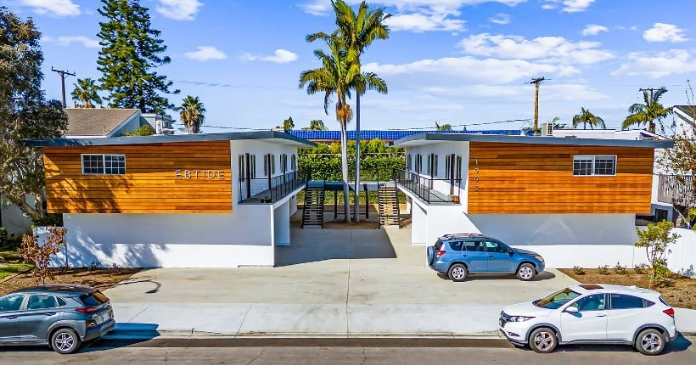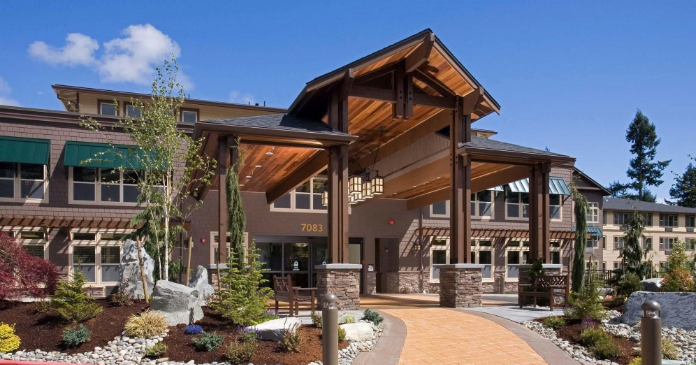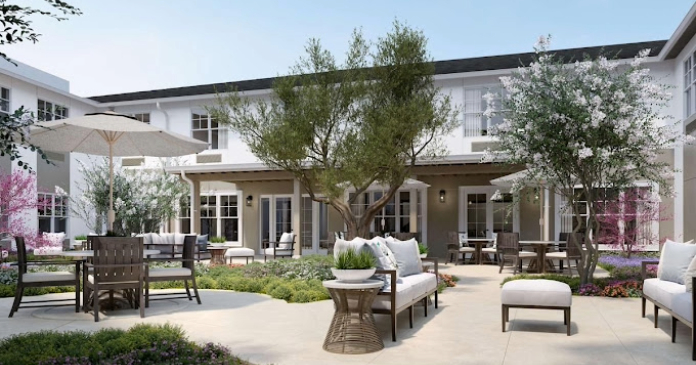This especially irritates Rob Pressman, the principal of Burbank, Calif.-based TGP, Inc. Landscape Architecture, who believes that aesthetics do not have to be discarded for the sake of sustainability.
Multifamily developers employ landscape architects like TGP, Inc. to create long-term infrastructure solutions that dramatically reduce water use and address storm-water runoff, yet offer attractive and healthy outdoor environments for residents of multifamily dwellings.
“While we have been designing with water conservation in mind for a number of years in California, one of the first concerns we must address in any landscape design project is how storm-water runoff will be handled. The water must be cleaned of oils and particulate matter from the roofs and other hard surfaces before it’s discharged into the city’s storm-water system that leads out to the sea,” said Pressman. “Before we start design, a civil engineer will have submitted a SUSMP plan (Storm Water Use Management Plan) to the city for approval. “So storm water runoff is first of all a regulatory issue. Only then does it become a design issue for us,” said Pressman.
There are a number of ways to address storm water collected on the roof and hardscape at upper levels, such as infiltration back into the ground and dry wells. However, on infill projects—which most urban multifamily projects are—where land is limited, storm water is typically addressed in two other ways. One is with filtration planters, filled with layers of soil and gravel that filter out solids and oils before the water is discharged.
The other is to capture all the storm water in an underground mechanical detention system, a tank to which water is routed and then mechanically filtered into a basin and pumped out into the street, devoid of particulates and oils, explained Pressman.
More often than not, on-structure multifamily projects end up using a combination of planters and tanks. “The more roof water you can treat in the filtration planters located on the podium level, the smaller the underground detention tank has to be and they can get pretty expensive,” said Pressman, adding that the civil engineer decides the size and capacity of the infiltration planters.
Some municipalities mandate how much of a project’s open space area must be planted. For instance, when designing the landscape for the 50-unit White Magnolia apartments in Encino, developed by Los Angeles-based Held Properties, TGP, Inc. was required by the City of Los Angeles to install one 24-inch box tree for every four units and plant at least 25 percent of the common open area, not including the 15-foot-wide front set back.
“To satisfy these requirements and meet the programmatic needs of the owner for a spa, fire pit, barbecue, dining area and seating area, TGP, Inc. divided the space into ‘rooms’ using planters and a long, linear water feature with recirculating water that spills over into a pool basin at one end and separates the spa on one side from the fire pit and seating area on the other. The spa area is separated by a glass wall used as a protective pool fence to comply with the requirement to have a five-foot barrier around any swimming pool or spa. “The glass is easy to care for and does not take away from the open-space ambience,” said Pressman.
As for plant materials, Pressman went with a drought tolerant Mediterranean palette to complement the building’s architectural theme, and planted olives, bougainvillea, date palms and Italian cypress.
Pressman said a trend popular in drought-ridden Los Angeles is a less manicured look, achieved through the use of native grasses and other sun-loving plants, like those he employed in the landscape design at the 35-unit Palm Drive luxury condo project in Beverly Hills for Etco Homes that was completed last year.
In response to the city’s desire for the predominant use of drought tolerant plant materials, TGP, Inc. designed both the front building setback and a landscaped paseo separating the two contemporary style buildings, with California natives such as Manzanita, Desert Broom and Giant Wild Rye.
Water savers
In most of its multifamily projects, TGP, Inc. utilizes new high-tech products that significantly save water and meet the most current requirements of AB 1881 State of California Model Water Efficient Landscape Ordinance (MWELO).
The ordinance lays out a plan where a project is given a water budget—a maximum amount of water the landscape can use—based on the square footage of the landscaped area and the local weather, to account for geographic differences. A project-specific, water-use estimate is then calculated based on the irrigation system and plant materials. The estimated water use must be less than the water budget for the project to move forward.
The MWELO was updated in December 2015, based on the current statewide drought conditions, and essentially tightened up the water budget calculations, so that about 15 to 25 percent less water is currently allowed when compared to the original MWELO, explained Pressman.
To meet those new requirements, TGP, Inc. irrigates planted areas with drip line (Netafim) irrigation systems installed two inches below the surface to prevent water loss by evaporation and to ensure that the plants’ root systems receive all of the water.
Part of the irrigation specification is to use all organic natural nutrients and or soil conditioners. TGP, Inc. specifies an automatic fertilization system by Sacramento-based EZ-Flo to inject micro doses of nutrients directly into the drip line irrigation system where the water is then applied directly in the root zone. Because the system uses the sub-surface irrigation system as its application mechanism, there is virtually no possibility of run-off, as there is no on-grade application of fertilizer.
“Our irrigation designer, Rick Dortch, recommends the EZ-Flo system because it is affordable, simple and low-tech, so even the newest member of a maintenance crew can quickly learn how the system works and be able to operate it without compromising the set-up. The system is maintenance free mechanically, does not require any electricity, therefore is considered ‘green’ and only requires filling of the nutrient tank once every four to six weeks,” said Pressman.
Meanwhile, irrigation zones are separated for similar plant type and solar exposure to ensure that drought-tolerant plant material is not overwatered. “Plant types that do well in shaded areas require and will receive more water,” said Pressman.
The sub-surface drip system is somewhere between 20 and 30 percent more efficient than traditional sprinkler systems, for several reasons. The water is applied sub-surface directly into the root zone so there is less evaporation, no overspray and no wind-drift. Not only do these benefits save water, they also eliminate water damage to windows, paving and furniture.
The EPA released its final WaterSense specification for weather-based irrigation controllers on November 3, 2011. TGP, Inc. specifies one such smart controller—the Hunter I-Core controller—on the multifamily projects it works on in California.
This WaterSense-labeled product is equipped with a “Solar Sync” ET sensor that calculates evapotranspiration and acts like a thermostat for the sprinkler system, telling it when to turn on and off, using local weather and landscape conditions to tailor watering schedules to actual conditions on the site. Instead of irrigating using a controller with a clock and a preset schedule, the I-core allows for watering schedules that better match plants’ water needs by monitoring the on-site temperature, solar radiation and rainfall so that automatic adjustments are made to the frequency and duration of the watering cycle as the weather changes.
According to Dortch, a smart controller can be as much as 25 percent more efficient than a traditional low-tech controller. The drip irrigation combined with the weather-based control system can add up to 40 percent or more water savings.
Water futures
Pressman and his fellow landscape architects at TGP, Inc. believe the design side of landscaping and irrigation is applying more significant water conservation techniques and strategies compared to just a few short years ago.
While some areas of the country utilize or recycle rainwater, Pressman notes that in Southern California, if recycled water is available, it’s typically mandated that it be used for landscape irrigation.
“This gets somewhat complicated for housing projects, as there is a reluctance to use recycled water in residential applications, and gets even more complicated if the residential projects have on-structure landscaping, which would require running the recycled water piping through the building.
“Where I see the largest opportunity for improvement is in long-term maintenance strategies and practices. If the new landscapes and irrigation systems are maintained with old habits, i.e. replace a dead plant with whatever is available at Home Depot or fix a leaking irrigation system with whatever sprinkler the maintenance crew has on the truck, it doesn’t take long for a new, modern and sustainable design to morph its way back to an old traditional high-water use system,” said Pressman.
Dollars and WaterSense
As utility rates rise and states and municipalities impose fines and penalties on water over-users, managing water use inside the buildings and in the common areas becomes a greater concern for multifamily owners, especially since utility costs are their largest expense, after debt servicing and overhead, said Michael Foote, senior regulatory counsel for NWP, a 20-year-old Costa Mesa, Calif.-based firm formed to help apartment owners with utility cost recovery, conservation and energy management. NWP was recently acquired by RealPage, which entered the multifamily utility billing space in 2005 with the acquisition of The Pleco Group.
Since the end of the Great Recession, multifamily has experienced unprecedented high rent and occupancy levels for the longest cycle in recent history, spurred by downsizing baby boomers and demand from Millennials, who are renting longer than prior generations, while being drawn to larger metros where job creation is strongest.
But within this “renter nation,” rent growth is outpacing wage growth, causing apartment owners to worry that incomes soon will no longer support rent rates, let alone increases. According to 2015 estimates from the Harvard Joint Center for Housing Studies, 11.4 million renters spend more than 50 percent of their income on housing. Add the rising cost of utilities to the rent and, at some point, renters will hit an affordability wall.
Meanwhile, at least 300,000 to 400,000 new apartments are needed this year to fill demand, says the National Multifamily Housing Council.
“In places like California, which is in the midst of a five-year drought, the state is taking drastic actions to mandate water-use reductions and that’s making it harder for developers to get new projects entitled,” said Jonah Schein, technical coordinator of homes and buildings at the EPA’s WaterSense Program.
“Communities often want to add housing. It adds to their tax base and generates economic activity that is a win-win, so they are looking for ways to allow developers to build. But new construction brings additional water use needs. If you are required to reduce water, but are about to add more gallons due to new demand, you have to reduce even more water elsewhere,” he said.
The EPA has developed a partnership program called WaterSense, sometimes referred to as the water equivalent of Energy Star, to help Americans save both water and money through the use of products, tips and techniques that reduce water consumption.
WaterSense has more than 17,000 products for the residential market that can help multifamily owners reduce water consumption in both new and existing apartment buildings and help developers meet the tighter water mandates imposed by states and municipalities across the nation.
Products that bear the WaterSense label—including faucets and aerators, toilets, showerheads and irrigation controllers—have been certified for both efficiency and performance.
“All products that earn the WaterSense label are third-party certified for efficiency and performance. So, in addition to proving they are efficient, they must pass performance criteria to ensure they perform as well or better then their conventional counterparts,” said Schein, adding that 1.1 trillion gallons of water was saved by the use of WaterSense-labeled products through 2014.
“We don’t have the 2015 numbers yet,” he said.
WaterSense is going a step further. In a joint effort to develop the first 1 to 100 score for water use, a benchmark comparable to what Energy Star offers energy use in multifamily properties and a variety of other building types through Energy Star Portfolio Manager, WaterSense and Energy Star have been working collaboratively for several years.
They reached out to apartment owners late last year in hopes of furthering this analysis, asking them to complete a survey by last October 30th for each of the buildings in the communities they own.
“The survey we used to develop our models comes from the Fannie Mae Green Initiative—the same survey used to create the EPA’s Energy Star benchmark,” said Schein, adding that WaterSense brings to the partnership expertise about water use and Energy Star brings expertise, background and knowledge on generating use-intensity models. Energy Star has had great success in implementing this approach through their online free tool, Portfolio Manager.
The survey gathered basic information about the properties, including the size and number of units, the average number of bedrooms and other important data that property managers who are trying to get a handle on water usage should know, said Schein.
“When launched, the scoring model will take all of that complicated information that contributes to a building’s efficiency and give us simple feedback. Efficiency can be very complicated, but at the end of the day everyone can understand a 1 to 100 score. Everyone knows 80 is pretty good, 30 is not so good and five is really bad,” he said.
EPA hopes to release the new scoring model and make it accessible within Portfolio Manager, which can be used to benchmark the performance of one building or a whole portfolio of buildings.
One of the major pieces of additional information on water that properties will need is the irrigated area, because most people are not tracking that as tightly as they should be, said Schein.
“Right now in Portfolio Manager there are 14,000 multifamily buildings that we would be able to score if we added irrigated area. That’s the only information we need them to provide,” he said.
Schein hopes that WaterSense and Energy Star will launch its 1 to 100 scoring tool this year so that owners and managers can get a clear picture of how they rate as far as water usage.
Foote, whose company provides a direct, automated interface into Energy Star Portfolio Manager to help NWP’s clients stay in compliance with ordinances and regulations, believes the new WaterSense scoring tool will help would-be renters looking for apartments, as well as investors looking to purchase them.
“Today there may be some incentive to fudge on how well a building is performing to keep the sale price up and the scoring will help to incentivize owners to upgrade their heating and cooling systems and add technology that improves performance,” said Foote.
















